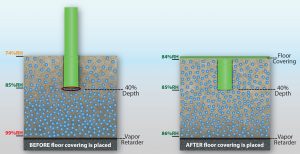How a Good RH Reading Limits Concrete Liability
Installers know moisture is part of any successful, and unsuccessful, flooring installation. The difference between the two outcomes rests with the measurement of when it is safe to bond the flooring to the concrete and plow towards project completion. A simple meter reading is all that lies between installation success and business failure.
Concrete interacts with the humidity of its environment. Once a floor covering is placed on a concrete slab, the relative humidity (RH) within the slab will equilibrate. It re-distributes itself throughout the thickness of the slab, the higher levels of moisture at the bottom of the slab move towards the top. When the flooring covers an otherwise “dry” concrete slab (acceptable RH at mid-slab depth), relative humidity migrates from down in the concrete to the surface. Knowing what the RH level is at this “mid” slab depth, allows you to understand what the conditions will be like on the surface of the concrete, once a flooring product is installed and the slab equilibrates. Install the floor too soon, and excess moisture cannot properly evaporate. The trapped moisture may require a complete floor re-installation. Contractors who push forward with floor installation risk many problems and professional liability for flooring failures.
Our knowledge of “moisture” and “relative humidity” makes all the difference. Most major floor covering and adhesive manufacturers in North America and Europe provide relative humidity (RH) specifications that work with their products. In order to avoid flooring failure, contractors need to accurately measure the moisture in the floor slab, as it relates to successful flooring installations. There are two kinds of meters. Moisture meters send an electromagnetic field approximately one inch beneath the concrete surface. Relative humidity meters, such as those produced by Wagner Meters, assemble the readings of probes placed at that “mid” slab depth, in numerous test sites throughout the slab.
The Moisture Meter Method
Moisture meters have important limitations. First, their measurement depth does not adequately reflect the drying condition of a whole concrete slab. Its findings assess the portion of concrete which is always drier than what lies beneath, so moisture meters should never cinch a final determination to install flooring. Also, the moisture meter’s electromagnetic field (EMF) could distort readings in the presence of any reinforcements of wire mesh embedded in the slab. In effect, these meters could present a much drier or wetter result than is truly the case. As Howard Kanare of CTLGroup points out, “It [the steel] will transmit that electromagnetic signal and the handheld meter will then indicate the floor was soaking wet … even if it isn’t.”
Concrete mix ingredients may also interfere with the accuracy of moisture meter readings. Since concrete amalgamates cement, water and aggregate, its contents may trigger moisture readings that are being influenced by the mix, not the moisture, of the concrete itself. As builders evolve eco-friendly concrete mixes, the properties within them are likely to change even further. The single dimension upon which moisture readings are gathered prove unable to take these variables adequately into account.
Other moisture tests have similar problems. The calcium chloride method (based on moisture vapor emissions), and the UK-based ‘hood’ method also indicate conditions only at the surface of the concrete slab. As the surface more closely reflects the building’s RH, the meter cannot determine conditions deeper down.
The Relative Humidity (RH) Method
 Relative humidity meters present a more thorough snapshot of concrete dryness. When RH is read by sensors placed 40% deep into the slab, builders get a sense of how completely the concrete has dried. They are better able to determine the impact that flooring installation will have on concrete’s subsequent equilibration. Builders using RH measurement can also make informed choices about the best applications for the adhesives, flooring or coating to apply over the slab. Wagner RH meters allow contractors to leave sensors in the concrete for future measurements, which is cost-effective. Armed with RH methodology, builders can take many measurements to ensure concrete equilibration before laying down a floor covering.
Relative humidity meters present a more thorough snapshot of concrete dryness. When RH is read by sensors placed 40% deep into the slab, builders get a sense of how completely the concrete has dried. They are better able to determine the impact that flooring installation will have on concrete’s subsequent equilibration. Builders using RH measurement can also make informed choices about the best applications for the adhesives, flooring or coating to apply over the slab. Wagner RH meters allow contractors to leave sensors in the concrete for future measurements, which is cost-effective. Armed with RH methodology, builders can take many measurements to ensure concrete equilibration before laying down a floor covering.
Industry standards, and manufacturer’s RH guidelines, require responsible and accurate RH measurements. Only then can contractors guarantee the integrity of their work. In this case, it’s a matter of choosing the best tool for the job: relative humidity meters.
